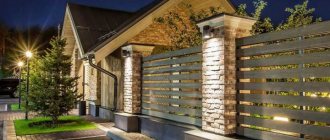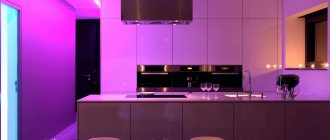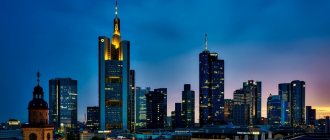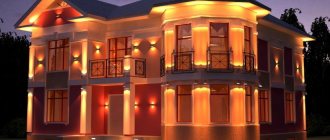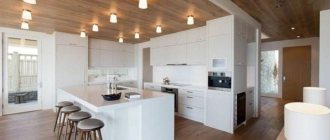The lighting design of the facade at night decorates the building, giving it a cozy and hospitable appearance. The article describes the principles of creation and functions of lighting the facades of private houses. You will learn the stages involved in developing an architectural lighting plan and what lighting equipment is used. The article will introduce you to the types of backlighting: flood, local and hidden, with their features and methods of implementation.
You can't help but admire it Source rupurt.com
About the functions of backlighting and the principles of its creation
Light design of facades is one of the ways of arranging the local area; owners of country houses are happy to use it as an additional element of the decor of their homes. Facade lighting can perform two functions:
- Aesthetic . Using techniques for illuminating the facade, you can highlight the architectural features of the house, give it a unique look, and make it stand out from the surrounding buildings.
- Practical . Facade lighting equipment illuminates not only the walls of the house. By decorating your home, you illuminate the surrounding area and ensure safe movement after sunset. For this purpose, individual elements are additionally illuminated - the porch or the entrance to the house.
To ensure that architectural lighting pleases the eye and does not cause trouble, it is arranged in compliance with the following principles:
- The system and its components must have the simplest and most reliable design possible . LED lamps have proven to be one of the easiest to use.
The charm of an illuminated facade Source netmostwebdesign.com
- The system must be economical in energy consumption.
- Facade lighting must be absolutely safe for residents of the house and their pets and comply with modern operational standards.
- It is desirable for the system to operate in automatic mode .
- The system must be maintainable .
Methods of organization and types of lighting
Facade lighting can be organized in different ways. Architectural practice includes lighting not only the main, front side of the building, but also the side walls. Contrary to popular belief, creating lighting design does not require the use of complex technical techniques and high consumption of materials. At the same time, it is necessary to strive for a harmonious result - all light sources must fit into the overall concept of lighting the area. The most common ways to organize lighting include:
- Installation of lighting sources on the walls of the building.
- Installation of hidden lamps .
- Use of remote lighting fixtures .
- Combination of methods.
Combined solution Source pa.unistica.com
All these lighting sources have different purposes and characteristics, so when choosing certain lighting elements, it is worth considering their functionality. To illuminate the facade, three types of lighting are organized:
- Decorative . Its only purpose is to create a spectacular view that will be the envy of neighbors and friends. In this case, it is allowed to highlight both individual facade details (for example, illumination of the roof of a house), as well as nearby plants and decorative elements of the local area.
- Technical . Auxiliary, enabling comfortable and safe use of stairs, house paths, doors.
- Accompanying . A type of technical; organized with the help of lighting fixtures equipped with special sensors that react by turning on when a person approaches.
Decorative lighting design Source ukrasheniyedoma.com
Choosing the location of devices
The placement of lighting equipment is as important a component as the choice of devices. When performing this stage, the designer must analyze both the parameters of the lighting fixtures (type, power) and the features of the structure. TO
As a rule, devices for flood lighting are mounted on separate supports or on objects located nearby. Also, a popular solution is to install devices on special brackets mounted directly on the structure.
Local lighting is often located near the element that it highlights. For large element sizes, the device can be placed on a support, the role of which is played by a protruding part, for example, a loggia.
The general rules for placing architectural and artistic lighting are as follows:
- it is necessary to ensure ease of installation of devices and their maintenance in the future;
- it is necessary to provide the technical possibility of connecting power supplies to the devices;
- a guarantee is required that the lighting equipment will be absolutely safe for people inside and outside the building.
Architectural lighting plan
Decorative lighting of facades is gradually turning into an integral attribute of a modern country house. Not only holiday and New Year's lighting, but also permanent lighting design is becoming increasingly in demand. When creating a project for external lighting of a country house, special attention is paid to the following aspects:
- Architectural style of housing , features of external decoration (color, texture of materials).
- Landscape features and location of the house.
- The location of the viewing area is the place from which the house is best viewed.
Specialized construction companies carry out work of any level of complexity, including design, installation and repair of lighting systems. Development of an architectural lighting plan includes the following stages:
- Concept development and lighting design. The lighting method is determined and lighting devices are selected for various parts of the facade.
Project lighting in a modern style Source pinterest.com.au
- Preparation of the electrical network project. Sets the lighting mode and backlight brightness.
- Selection and purchase of equipment (luminaires, lamps, spotlights).
- Installation and commissioning.
See also: Catalog of companies that specialize in electrical work.
Nuances of electrical installation work
When installing and connecting lighting fixtures in the yard, several important nuances should be taken into account:
- Before starting work, draw up a yard lighting diagram linked to the site plan - this will save time and money spent on incorrect calculations.
- It is more expedient to lay the electric cable in the ground - this will preserve the aesthetics of the yard; the depth of its location should be at least 0.8 m.
- All lamps must have a quality certificate allowing them to be used outdoors. Otherwise, over time, the housing may collapse from exposure to atmospheric factors.
- The connection points and connections of the supply wires must be buried in a sealed box that prevents moisture from entering.
- Street wires running along the open part of the facades must be protected from exposure to sunlight.
- You can install solar-powered LED lamps, but you won't get much light from them.
Types of lighting
Properly selected lighting for the facade of a country house can not only highlight the advantages of the building and the surrounding landscape design, but also hide the shortcomings (if any). To organize night illumination, professionals offer several types of street lighting.
Filling (filling)
A common option is when the building is completely illuminated, relevant for a separate object. An example of flood light is the lighting of various historical monuments, museums and theaters, whose view is not obscured by other buildings. Flood lighting has the following features:
- Lighting is created for the entire building , from the foundation to the roof.
Fill light Source www.tnl.de
A universal way to highlight a home Source northernnurseriesstonecenter.com
- For the method, it is possible to use two types of spotlights . More powerful devices create a basic diffuse light over the entire surface. Smaller spotlights highlight significant architectural details.
- The method is considered universal . Thanks to its intensity, the illumination not only makes the house stand out, but also at the same time creates a visibility zone around, which allows us to consider this option as optimal in terms of the ratio of financial expenses and results.
- There are some limitations in use . The method is rarely used in small areas. As a rule, such an area is characterized by dense development, in which it is impossible to identify the dominant structure, and the effect is lost.
Video description
About contour lighting in the following video:
Silhouette
Silhouette lighting creates an unaccentuated light background; the structure appears against a dark background, attention to detail is not drawn. Such hidden lighting for a country house can be successfully combined with local lighting; each of them serves to emphasize individual details of the structure, only the task is performed in different ways. The main idea is to reveal an element, to outline its shape using a source hidden behind the silhouette of the house (decor, architectural detail, plant). In many modern projects, such light pouring out of nowhere has an additional functional meaning.
Silhouette against the background of the night Source www.accentslighting.com
Contour
A method of decoratively highlighting the outline of architectural details of a building (stairs, balconies, bay windows); Often a specific outline of the architecture is highlighted. Fluorescent and LED lighting lamps are suitable for this method; lamps are mounted in the corners of the house, in window and door openings, and on the roof. In private homes, contour lighting is used mainly during the New Year holidays. To create colorful illumination, diode strips, duralight (a type of garland), and multi-colored lamps are used.
Outline design Source aovox.com
Main conclusions
Contour lighting of buildings is used both to improve the decorative properties of the facade, and from a practical side - to increase visibility in the surrounding area at night. Lighting devices used for such a lighting system must meet the following requirements:
- Maintain operating parameters in any weather and outdoor conditions.
- The dispersion of the light flux is within the range of 10 to 60 degrees.
- The case must have good protection from major external factors - shock, precipitation, dust, rain and moisture.
Depending on the purpose of the building and its architectural features, contour lighting can have several modifications - local, flood, emphasizing the perimeter, background, dynamic and in the form of a light facade.
If you have information about what else contour lighting can be or simply want to supplement the information on any of the points discussed, be sure to share it in the comments.
Equipment
For façade lighting, professionals use a wide variety of lighting equipment, which includes the following lighting materials:
- LED spotlights and lamps . They can be monochrome or use RGB technology and change color.
- Cantilever luminaires with metal halide lamps . Recently, they have been used quite rarely for facade lighting.
- Gas-discharge (fluorescent) lamps.
- Spotlights under DRL lamp.
- LED strips and garlands . Long gone are the days when only the New Year tree was decorated with garlands. In modern design, garlands with various effects (mesh, rain, waterfall) are a favorite decoration technique.
